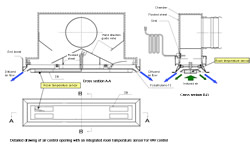Honda Wako Building
Perimeter-less air conditioning
 |
|||
| Comparison of perimeter heat loads | |||
 |
|||
High-performance low-e glass has been adopted for the exterior glass of the north and south atriums. These atriums face the exterior wall, resulting in perimeter-less air conditioning and a significant reduction in air conditioning load.
Realization of environmental adjustment systems for each season
 |
|||
| Natural ventilation system | |||
 |
|||
・Summer
If the temperature at the top of the south atrium exceeds a set value, exhaust air fans are operated to discharge hot air. The volume of second and third floor return air reduction balances the volume of hot air discharge.
・Spring and autumn
Natural ventilation and night purge is operated to open windows at the bottom and top of the atriums. Motorized ventilating openings are installed at the bottom of the south and north atriums, and, at the top of each atrium, “Natural Ventilation Recommended" is displayed on the central supervisory board only when weather conditions are suitable for natural ventilation. The operation manager decides whether to operate the natural ventilation.
・Winter
Cold air near the window is collected from the suction openings at the bottom of the atriums before it flows into the office space. Alternatively, linear fans are installed in the floor fronting south and north atriums, between office spaces and atriums, to block the thermal effect of the atriums
Air control opening with an integrated room temperature sensor for VAV control
 |
|||
| Detailed drawing of air control opening with an integrated room temperature sensor for VAV control | |||
 |
 |
 |
|
For VAV zoning control in the large, column-less, bright, open working space, we developed air control openings with an integrated room temperature sensor that is incorporated into the face of each air outlet and detects the room temperature from induced air.
Previous Building |
 |
 |
 |
 |
 |
 Next Building Next Building |
CASBEE is a method for rating the environmental performance of buildings using Building Environmental Efficiency (BEE) as an indicator, which is based on the results of separate scores obtained for Q-1~Q-3 (Quality) and LR-1~LR-3 (Load Reduction).















 | Copyright © 2008 Institute for Building Environment and Energy Conservation, All Rights Reserved.
| Copyright © 2008 Institute for Building Environment and Energy Conservation, All Rights Reserved.